A) The truffle spores are probably wind dispersed.
B) Truffles produce an odor that mammals can detect and find attractive.
C) Truffles probably produce toxins that can harm the mammals that eat them.
D) Truffle fruiting bodies are important in decomposition of wood.
Correct Answer

verified
Correct Answer
verified
Multiple Choice
At which stage of a basidiomycete's life cycle would reproduction be halted if an enzyme that prevented the fusion of hyphae was introduced?
A) fertilization
B) karyogamy
C) plasmogamy
D) germination
Correct Answer

verified
Correct Answer
verified
Multiple Choice
Arrange the following in order from largest to smallest.
A) ascomycete, ascocarp, ascus, ascospore
B) ascomycete, ascus, ascospore, ascocarp
C) ascocarp, ascomycete, ascus, ascospore
D) ascocarp, ascus, ascospore, ascomycete
Correct Answer

verified
Correct Answer
verified
Multiple Choice
The most important adaptive advantage associated with the filamentous nature of fungal mycelia is
A) the ability to form haustoria and parasitize other organisms.
B) the potential to inhabit almost all terrestrial habitats.
C) the increased chance of contact between mating types.
D) an extensive surface area well suited for invasive growth and absorptive nutrition.
Correct Answer

verified
Correct Answer
verified
Multiple Choice
All fungi are
A) symbiotic.
B) heterotrophic.
C) flagellated.
D) decomposers.
Correct Answer

verified
Correct Answer
verified
Multiple Choice
Asexual reproduction in yeasts occurs by budding. Due to unequal cytokinesis, the "bud" cell receives less cytoplasm than the parent cell. Which of the following statements should be an accurate characterization of the smaller cell until it reaches the size of the larger cell?
A) It should produce fewer fermentation products per unit time.
B) It should be transcriptionally less active.
C) It should have reduced motility.
D) It should have a smaller nucleus.
Correct Answer

verified
Correct Answer
verified
Multiple Choice
Use the following information to answer the question.
Along with bacteria and protozoa, some chytrid fungi live in the digestive tracts of cattle and aid in the digestion of plant matter; thus, all three groups represent potential mutualists with cattle. In an experiment designed to test how much of a contribution to cell wall digestion was made by fungi in one part of the stomach (rumen) , Lee et al. fed grain to cattle and then removed samples of the rumen contents. They took these samples to the laboratory and experimentally treated them with various chemicals to produce fractions that contained (A) only fungi, (B) only bacteria, (C) only protozoa, and (D) all of the potential mutualists. They then measured the percent of the cell wall that was degraded (see the figure) .
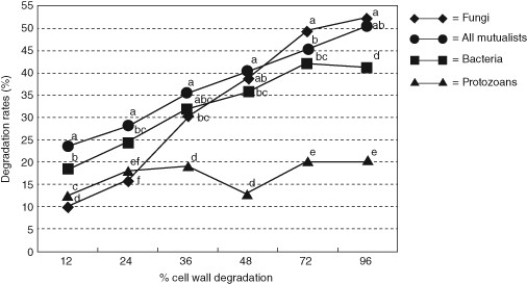 Degradation rates of cell walls extracted from Orchard grass by the monoculture system to assess the relative contributions of digestion by bacterial (square) , protozoan (triangle) , and fungal (diamond) systems, and all components (closed circle) as a control. The lowercase letters above the spots indicate statistical significance; mean values with different letters are significantly different (P < 0.05) .
Which of the following reasons provides the best explanation for the use of a control that contained all potential mutualists? Comparison to a fraction that contained all potential mutualists allowed the researchers to ________.
Degradation rates of cell walls extracted from Orchard grass by the monoculture system to assess the relative contributions of digestion by bacterial (square) , protozoan (triangle) , and fungal (diamond) systems, and all components (closed circle) as a control. The lowercase letters above the spots indicate statistical significance; mean values with different letters are significantly different (P < 0.05) .
Which of the following reasons provides the best explanation for the use of a control that contained all potential mutualists? Comparison to a fraction that contained all potential mutualists allowed the researchers to ________.
A) demonstrate that their laboratory culture conditions allowed all potential mutualists to grow
B) determine how much each potential mutualist contributed to cell wall degradation
C) better mimic the conditions of the rumen
D) demonstrate that the various potential mutualists did not compete with each other
Correct Answer

verified
Correct Answer
verified
Multiple Choice
Fossil fungi date back to the origin and early evolution of plants. What combination of environmental and morphological change is similar in the evolution of both fungi and plants?
A) presence of "coal forests" and change in mode of nutrition
B) periods of drought and presence of filamentous body shape
C) predominance in swamps and presence of cellulose in cell walls
D) colonization of land and loss of flagellated cells
Correct Answer

verified
Correct Answer
verified
Multiple Choice
Use the following information to answer the question.
Canadian and Swiss researchers wanted to know if the diversity of arbuscular mycorrhizal fungi (AMF) was important to the productivity of grasslands (M.G.A. van der Heijden, J. N. Klironomos, M. Ursic, P. Moutoglis, R. Streitwolf-Engel, T. Boler, A. Wiemken, and I. R. Sanders. 1998. Mycorrhizal fungal diversity determines plant biodiversity, ecosystem variability, and productivity. Nature 396:69-72) . Specifically, they wanted to know if it mattered which specific AMF species were present, or just that some type of AMF was present. They grew various plants in combination with one of four AMF species (A, B, C, and D) , no AMF species (O) , or all four AMF species together (A + B + C + D) ; and they measured plant growth under each set of conditions. All plant species were grown in each plot, so they always competed with each other with the only difference being which AMF species were present.
On the graphs, the x-axis labels indicate the number and identity of AMF species (bar 0 = no fungi; bars A - D = individual AMF species; bar A + B + C + D = all AMF species together) . The y-axis indicates the amount (grams) of plant biomass for the species shown in italics above each graph. Graph e is the total biomass (grams) of all 11 plant species combined; graph f is the biomass of Bromus erectus plants only, separated from the total.
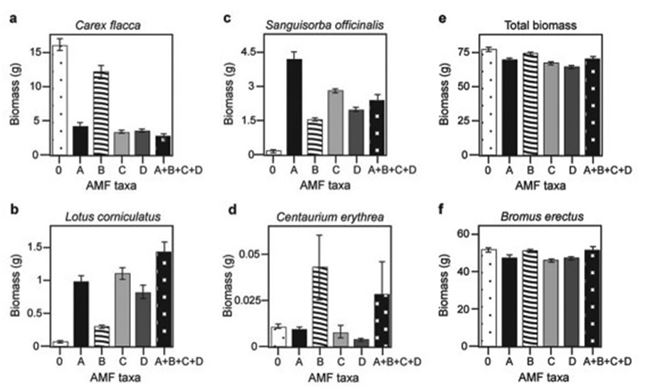 What is the major difference between Bromus erectus (graph f) and the other plant species (graphs a-d) included in the study?
What is the major difference between Bromus erectus (graph f) and the other plant species (graphs a-d) included in the study?
A) Bromus erectus grows best with a diversity of fungal partners.
B) Bromus erectus is unaffected by AMF diversity.
C) Bromus erectus does not form mycorrhizal associations.
D) Bromus erectus produces very little biomass regardless of AMF.
Correct Answer

verified
Correct Answer
verified
Multiple Choice
Why are mycorrhizal fungi superior to plants at acquiring mineral nutrition from the soil?
A) Hyphae are 100 to 1,000 times larger than plant roots.
B) Hyphae have a smaller surface area-to-volume ratio than do the hairs on a plant root.
C) Mycelia are able to grow in the direction of food.
D) Fungi secrete extracellular enzymes that can break down large molecules.
Correct Answer

verified
Correct Answer
verified
Multiple Choice
Use the following information to answer the question.
Along with bacteria and protozoa, some chytrid fungi live in the digestive tracts of cattle and aid in the digestion of plant matter; thus, all three groups represent potential mutualists with cattle. In an experiment designed to test how much of a contribution to cell wall digestion was made by fungi in one part of the stomach (rumen) , Lee et al. fed grain to cattle and then removed samples of the rumen contents. They took these samples to the laboratory and experimentally treated them with various chemicals to produce fractions that contained (A) only fungi, (B) only bacteria, (C) only protozoa, and (D) all of the potential mutualists. They then measured the percent of the cell wall that was degraded (see the figure) .
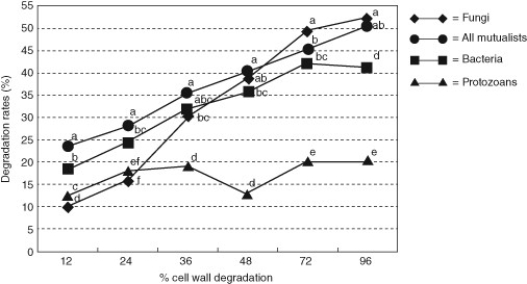 Degradation rates of cell walls extracted from Orchard grass by the monoculture system to assess the relative contributions of digestion by bacterial (square) , protozoan (triangle) , and fungal (diamond) systems, and all components (closed circle) as a control. The lowercase letters above the spots indicate statistical significance; mean values with different letters are significantly different (P < 0.05) .
Predict the results if the researchers had used a control that contained no potential mutualists (negative control) .
Degradation rates of cell walls extracted from Orchard grass by the monoculture system to assess the relative contributions of digestion by bacterial (square) , protozoan (triangle) , and fungal (diamond) systems, and all components (closed circle) as a control. The lowercase letters above the spots indicate statistical significance; mean values with different letters are significantly different (P < 0.05) .
Predict the results if the researchers had used a control that contained no potential mutualists (negative control) .
A) The negative control would have as much cell wall degradation as was shown by fungi alone.
B) The negative control would have very little cell wall degradation.
C) The negative control would have as much cell wall degradation as all three of the potential mutualists together.
D) The negative control would have more cell wall digestion than protozoans alone.
Correct Answer

verified
Correct Answer
verified
Multiple Choice
Use the following information to answer the question.
Suzanne Simard and colleagues knew that the same mycorrhizal fungal species could colonize multiple types of trees. They wondered if the same fungal individual would colonize different trees, forming an underground network that potentially could transport carbon and nutrients from one tree to another (S. Simard et al. 1997. Net transfer of carbon between mycorrhizal tree species in the field. Nature 388:579-82) .
Pots containing seedlings of three different tree species were set up and grown under natural conditions for three years (Fig.A) . Two of the three species (Douglas fir, birch) could form ectomycorrhizal connections with the same fungal species, but the third species (cedar) could not form an ectomycorrhizal connection with the fungal species. In some of the pots, the researchers placed airtight bags over the Douglas fir and birch seedlings and injected carbon dioxide made from carbon-13 into the bags with the Douglas fir and carbon dioxide made from carbon-14 into the bags with the birch. (¹³C and ¹⁴C are different isotopes of carbon that can be detected and measured by researchers.) As the seedlings photosynthesized, the carbon dioxide was converted into sugars that could be tracked and measured by the researchers. The researchers measured whether the sugars in each plant contained only the carbon isotope that was in the air of their plastic bag or also the carbon isotope from the air around the other plant.
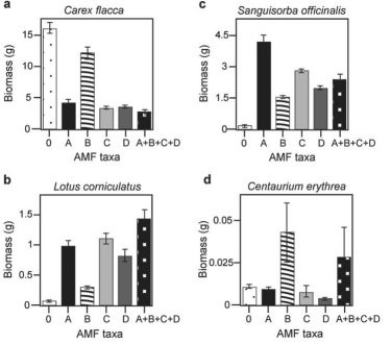 Simard et al. (1997) further hypothesized that if reciprocal transfer did occur, it would be a source-sink relationship driven by photosynthetic rates. That is, if one seedling is in full sun and the other in deep shade, there will be a net movement of carbon from the seedling in full sun to the one in deep shade. If a shade were placed over the birch seedlings and the cedar, and the Douglas fir was left in full sun, what result could Simard and colleagues expect?
Simard et al. (1997) further hypothesized that if reciprocal transfer did occur, it would be a source-sink relationship driven by photosynthetic rates. That is, if one seedling is in full sun and the other in deep shade, there will be a net movement of carbon from the seedling in full sun to the one in deep shade. If a shade were placed over the birch seedlings and the cedar, and the Douglas fir was left in full sun, what result could Simard and colleagues expect?
A) More ¹³C would be found in the birch than ¹⁴C in the Douglas fir.
B) The amounts of ¹³C and ¹⁴C would be equal in the Douglas fir and in the birch.
C) The most ¹³C would be found in the cedar.
D) The most ¹⁴C would be found in the cedar.
Correct Answer

verified
Correct Answer
verified
Multiple Choice
Use the information to answer the following question.
The figure depicts the outline of a large fairy ring that has appeared overnight in an open meadow, as viewed from above. The fairy ring represents the furthest advance of this mycelium through the soil. Locations A-D are all 0.5 meters below the soil surface.
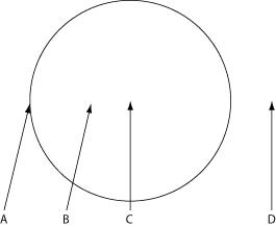 At which location should one find the lowest concentration of fungal enzymes, assuming that the enzymes do not diffuse far from their source and that no other fungi are present in this habitat?
At which location should one find the lowest concentration of fungal enzymes, assuming that the enzymes do not diffuse far from their source and that no other fungi are present in this habitat?
A) A
B) B
C) C
D) D
Correct Answer

verified
Correct Answer
verified
Multiple Choice
Use the following information to answer the question.
There is much discussion in the media about protecting biodiversity. But does biodiversity really matter? Canadian and Swiss researchers wanted to know if the diversity of arbuscular mycorrhizal fungi (AMF) was important to the productivity of grasslands (M.G.A. van der Heijden, J. N. Klironomos, M. Ursic, P. Moutoglis, R. Streitwolf-Engel, T. Boler, A. Wiemken, and I. R. Sanders. 1998. Mycorrhizal fungal diversity determines plant biodiversity, ecosystem variability, and productivity. Nature 396:69-72) . Specifically, they wanted to know if it mattered which specific AMF species were present, or just that some type of AMF was present. They grew various plants in combination with one of four AMF species (A, B, C, and D) , no AMF species (O) , or all four AMF species together (A + B + C + D) ; and they measured plant growth under each set of conditions. All plant species were grown in each plot, so they always competed with each other, with the only difference being which AMF species were present.
On the graphs, the x-axis labels indicate the number and identity of AMF species (bar 0 = no fungi; bars A - D = individual AMF species; bar A + B + C + D = all AMF species together) . The y-axis indicates the amount (grams) of plant biomass for the species shown in italics above each graph.
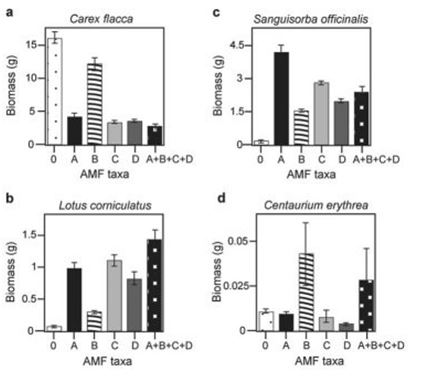 In graph b in the figure, which of the following best explains the data given about Lotus corniculatus?
In graph b in the figure, which of the following best explains the data given about Lotus corniculatus?
A) This plant grows best when AMF taxa A or C is present.
B) Lotus corniculatus does not form mycorrhizal associations.
C) Mycorrhizal fungi parasitize the plant's roots when they are present, reducing its growth.
D) This plant forms multiple AMF associations, growing best with increased fungal diversity.
Correct Answer

verified
Correct Answer
verified
Multiple Choice
A fungal spore germinates, giving rise to a mycelium that grows outward into the soil surrounding the site where the spore originally landed. Which of the following accounts for the fungal movement, as described here?
A) karyogamy
B) mycelial flagella
C) breezes distributing spores
D) cytoplasmic streaming in hyphae
Correct Answer

verified
Correct Answer
verified
Multiple Choice
Use the information to answer the following question.
The figure depicts the outline of a large fairy ring that has appeared overnight in an open meadow, as viewed from above. The fairy ring represents the furthest advance of this mycelium through the soil. Locations A-D are all 0.5 meters below the soil surface.
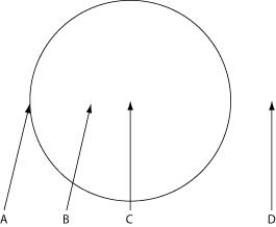 Which location is nearest to basidiocarps?
Which location is nearest to basidiocarps?
A) A
B) B
C) C
D) D
Correct Answer

verified
Correct Answer
verified
Multiple Choice
Some nematode worms suck plant juices from the roots of plants and are economically important agricultural pests. Some fungi are usually decomposers of plant material, but some trap and kill nematodes at times. Arthrobotrys traps and kills nematodes, especially when they lack nitrogen sources. These two facts suggest that farmers could find Arthrobotrys an important tool in combating nematode infestations. Which of the following research questions would make a good starting point for developing such a defense against plant-sucking nematodes?
A) Does nitrogen fertilization of crops affect the likelihood that Arthrobotrys will trap and kill nematodes?
B) Do nitrogen-fixing bacteria provide nitrogen to the fungi?
C) What is the evolutionarily oldest method of trapping nematodes?
D) What mechanisms do nematodes have that could allow them to escape from Arthrobotrys?
Correct Answer

verified
Correct Answer
verified
Multiple Choice
Use the following information to answer the question.
Heterobasidion is a basidiomycete that contributes to mortality of trees. Kuhlman isolated 23 strains of Heterobasidion and applied them to 16 seedlings of 10 different tree species. Partial results of this experiment are shown in the table. (From Kuhlman, E. G. 1970. Seedling inoculations with Fomes annosus show variation in virulence and in host susceptibility. Phytopathology 60:1743-1746. https://www.apsnet.org/publications/phytopathology/backissues/Documents/1970Articles/Phyto60n12_1743.PDF)
% mortality of five host species from five Heterobasidion isolates
 Which of the following conclusions can best be drawn from these results?
Which of the following conclusions can best be drawn from these results?
A) All tree species are susceptible to Heterobasidion.
B) Heterobasidion strains are equally lethal to all tree species.
C) Heterobasidion strains vary in their effect on tree species.
D) Some strains of Heterobasidion reduce tree mortality.
Correct Answer

verified
Correct Answer
verified
Multiple Choice
Use the following information to answer the question.
Along with bacteria and protozoa, some chytrid fungi live in the digestive tracts of cattle and aid in the digestion of plant matter; thus, all three groups represent potential mutualists with cattle. In an experiment designed to test how much of a contribution to cell wall digestion was made by fungi in one part of the stomach (rumen) , Lee et al. fed grain to cattle and then removed samples of the rumen contents. They took these samples to the laboratory and experimentally treated them with various chemicals to produce fractions that contained (A) only fungi, (B) only bacteria, (C) only protozoa, and (D) all of the potential mutualists. They then measured the percent of the cell wall that was degraded (see the figure) .
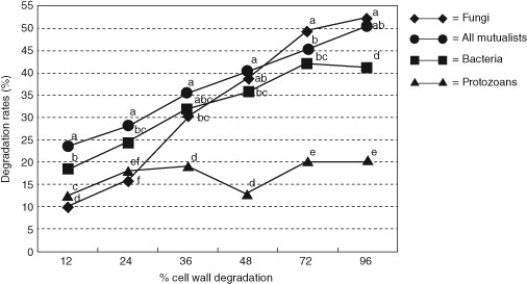 Degradation rates of cell walls extracted from Orchard grass by the monoculture system to assess the relative contributions of digestion by bacterial (square) , protozoan (triangle) , and fungal (diamond) systems, and all components (closed circle) as a control. The lowercase letters above the spots indicate statistical significance; mean values with different letters are significantly different (P < 0.05) .
Which of the following conclusions can be drawn correctly from the data?
Degradation rates of cell walls extracted from Orchard grass by the monoculture system to assess the relative contributions of digestion by bacterial (square) , protozoan (triangle) , and fungal (diamond) systems, and all components (closed circle) as a control. The lowercase letters above the spots indicate statistical significance; mean values with different letters are significantly different (P < 0.05) .
Which of the following conclusions can be drawn correctly from the data?
A) Of all three potential mutualists, protozoa contribute the most to cell wall digestion.
B) Of all three potential mutualists, fungi contribute the least to cell wall digestion.
C) Fungi contribute as much to cell wall degradation as all the potential mutualists together.
D) The cattle did not benefit from the presence of fungi; therefore, the fungi are not mutualistic with the cattle.
Correct Answer

verified
Correct Answer
verified
Multiple Choice
Plasmogamy can directly result in which of the following?
A) cells with a single haploid nucleus or dikaryotic cells
B) heterokaryotic cells or dikaryotic cells
C) heterokaryotic cells or cells with two diploid nuclei
D) dikaryotic cells or cells with two diploid nuclei
Correct Answer

verified
Correct Answer
verified
Showing 21 - 40 of 75
Related Exams